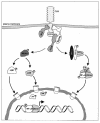Role of Toll-like receptors in pathogen recognition
- PMID: 14557290
- PMCID: PMC207104
- DOI: 10.1128/CMR.16.4.637-646.2003
Role of Toll-like receptors in pathogen recognition
Abstract
The innate immune system relies on a vast array of non-clonally expressed pattern recognition receptors for the detection of pathogens. Pattern recognition receptors bind conserved molecular structures shared by large groups of pathogens, termed pathogen-associated molecular patterns. The Toll-like receptors (TLRs) are a recently discovered family of pattern recognition receptors which show homology with the Drosophila Toll protein and the human interleukin-1 receptor family. Engagement of different TLRs can induce overlapping yet distinct patterns of gene expression that contribute to an inflammatory response. The TLR family is characterized by the presence of leucine-rich repeats and a Toll/interleukin-1 receptor-like domain, which mediate ligand binding and interaction with intracellular signaling proteins, respectively. Most TLR ligands identified so far are conserved microbial products which signal the presence of an infection, but evidence for some endogenous ligands that might signal other danger conditions has also been obtained. Molecular mechanisms for pathogen-associated molecular pattern recognition still remain elusive but seem to be more complicated than initially anticipated. In most cases, direct binding of microbial ligands to TLRs still has to be demonstrated. Moreover, Drosophila TLRs bind endogenous ligands, generated through a proteolytic cascade in response to an infection. In the case of endotoxin, recognition involves a complex of TLR4 and a number of other proteins. Moreover, TLR heterodimerization further extends the spectrum of ligands and modulates the response towards specific ligands. The fact that TLR expression is regulated in both a cell type- and stimulus-dependent fashion further contributes to the complexity.
Figures



References
-
- Ahmad-Nejad, P., H. Hacker, M. Rutz, S. Bauer, R. M. Vabulas, and H. Wagner. 2002. Bacterial CpG-DNA and lipopolysaccharides activate Toll-like receptors at distinct cellular compartments. Eur. J. Immunol. 32:1958-1968. - PubMed
-
- Alexopoulou, L., A. C. Holt, R. Medzhitov, and R. A. Flavell. 2001. Recognition of double-stranded RNA and activation of NF-κB by Toll-like receptor 3. Nature 413:732-738. - PubMed
-
- An, H., H. Xu, Y. Yu, M. Zhang, R. Qi, X. Yan, S. Liu, W. Wang, Z. Guo, Z. Qin, and X. Cao. 2002. Up-regulation of TLR9 gene expression by LPS in mouse macrophages via activation of NF-κB, ERK and p38 mitogen-activated protein kinase signal pathways. Immunol. Lett. 81:165-169. - PubMed
-
- Aravind, L., V. M. Dixit, and E. V. Koonin. 1999. The domains of death: evolution of the apoptosis machinery. Trends Biochem. Sci. 24:47-53. - PubMed
-
- Arbour, N. C., E. Lorenz, B. C. Schutte, J. Zabner, J. N. Kline, M. Jones, K. Frees, J. L. Watt, and D. A. Schwartz. 2000. TLR4 mutations are associated with endotoxin hyporesponsiveness in humans. Nat. Genet. 25:187-191. - PubMed
Publication types
MeSH terms
Substances
LinkOut - more resources
Full Text Sources
Other Literature Sources
Molecular Biology Databases

